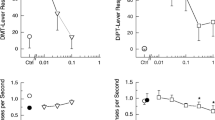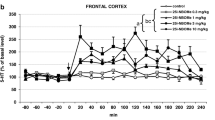Abstract
The binding affinities of four hallucinogenic agents were analyzed at nine neurotransmitter binding sites in human cortex. d-Lysergic acid diethylamide (d-LSD), N,N-dimethyltryptamine (DMT), 1-(2,5-dimethoxy-4-iodophenyl)-2-aminopropane (DOI) and 1-(2,5-dimethoxy-4-bromophenyl)-2-aminopropane (DOB) display highest affinity for the recently identified “DOB binding site” labeled by 77Br-R(-)DOB. The phenalkylamines, DOI and DOB, display subnanomolar affinity for the 77Br-R(-)DOB-labeled site, whereas the indolealkylamines, d-LSD and DMT, display nanomolar affinity for this site. d-LSD was the most potent of the four hallucinogens at six of the other eight sites analyzed in this study. All four hallucinogens also display high affinity for the 5-hydroxytryptamine2 (5-HT2) receptor subtype, with potencies ranging from 4 to 360 nM. Marked differences in relative affinities were observed between the indolealkylamines and the phenalkylamines at the 5-HT1A, 5-HT1D, and DOB binding sites. These rank-order differences in affinities are likely to account for the differing effects of these agents in various biochemical and physiological assays.
Similar content being viewed by others
References
Aghajanian GK, Foote WE, Sheard MH (1970) Action of psychotogenic drugs on single midbrain raphe neurons. J Pharmacol Exp Ther 171:178–187
Appel JB, Cunningham KA (1986) The use of drug discrimination procedures to characterize hallucinogenic drug actions. Psychopharmacol Bull 22:959–967
Battaglia G, Shannon M, Titeler M (1984) Guanyl nucleotide and divalent cation regulation of cortical S2 serotonin receptors. J Neurochem 43:1213–1219
Colpaert FC, (1984) Cross generalization with LSD and yohimbine in the rat. Eur J Pharmacol 102:541–544
Colpaert FC, Niemegeers CJE, Janssen PAJ (1982) A drug discrimination analysis of lysergic acid diethylamide (LSD): in vivo agonist and antagonist effects of purported 5-hydroxytryptamine antagonists and of pirenperone, a LSD antagonist. J Pharmacol Exp Ther 221:206–214
Colpaert FC, Meert TF, Niemegeers CJE Janssen PAJ (1985) Behavioral and 5-HT antagonist effects of ritanserin: a pure and selective antagonist of LSD discrimination in rat. Psychopharmacology 86:45–54
Conn PJ, Sanders-Bush E (1984) Selective 5-HT2 antagonists inhibit serotonin stimulated phosphatidylinositol metabolism in cerebral cortex. Neuropharmacology 23:993–996
Conn PJ, Sanders-Bush E (1985) Serotonin-stimulated phosphoinositide turnover: mediation by the S2 binding site in rat cerebral cortex but not in subcortical regions. J Pharmacol Exp Ther 234:195–203
Freedman DX, Gottlieb R, Lovell RA (1970) Psychotomimetic drugs and brain 5-hydroxytryptamine metabolism. Biochem Pharmacol 19:1181–1188
Glennon RA (1985) Involvement of serotonin in the action of hallucinogenic drugs. In: Green AR (ed) Neuropharmacology of serotonin. Oxford University Press. Oxford, pp 253–280
Glennon RA, Rosecrans JA (1982) Indolealkylamine and phenalkylamines hallucinogens: a brief overview. Neurosci Behav Rev 6:489–497
Glennon RA, Young R, Rosecrans JA (1983) Antagonism of the effects of the hallucinogen DOM and the purported 5-HT agonist quipazine by 5-HT2 antagonists. Eur J Pharmacol 91:189–196
Glennon RA, Titeler M, McKenney JD (1984) Evidence for 5-HT2 involvement in the mechanism of action of hallucinogenic agents. Life Sci 35:2505–2511
Glennon RA, Titeler M, Young R (1986) Structure-activity relationships and mechanism of action of hallucinogenic agents based on drug discrimination and radioligand binding studies. Psychopharmacol Bull 22:953–958
Haigler HJ, Aghajanian GK (1973) Mescaline and LSD: direct and indirect effects on serotonin-containing neurons in brain. Eur J Pharmacol 21:53–60
Halaris AE (1982) Nerve terminal effects of indoleamine psychotomimetics on 5-hydroxytryptamine. Neurosci Behav Rev 6:483–487
Heuring RE, Peroutka SJ (1987) Characterization of a novel 3H-5-hydroxytryptamine binding site subtype in bovine brain membranes. J Neurosci 7:894–903
Kendall DA, Nahorski SR (1985) 5-hydroxytryptamine-stimulated inositol phospholipid hydrolysis in rat cerebral cortex slices: Pharmacological characterization and effects of antidepressants. J Pharmacol Exp Ther 233:473–479
Lyon RA, Davis KH, Titeler M (1987) 3H-DOB (4-bromo-2,5-dimethoxyphenylisopropylamine) labels a guanyl nucleotidesensitive state of cortical 5-HT2 receptors. Mol Pharmacol 31:194–199
Nielson EB, Ginn SR, Cunningham KA, Appel JB (1985) Antagonism of the LSD cue by putative serotonin antagonists: relationship to inhibition of in vivo 3H-spiroperidol binding. Behav Brain Res 16:171–176
Peroutka SJ, Snyder SH (1979) Multiple serotonin receptors: differential binding of 3H-5-hydroxytryptamine, 3H-lysergic acid diethylamide and 3H-spiroperidol Mol Pharmacol 16:687–699
Pierce PA, Peroutka SJ (1987) Correlation of psychotropic drug effects at neurotransmitter receptors with phosphatidylinositol hydrolysis in rat cerebral cortex. Soc Neurosci Abstr 13:801
Titeler M, Herrick K, Lyon RA, McKenney JD, Glennon RA (1985) 3H-DOB: a specific agonist radioligand for 5-HT2 serotonin receptors. Eur J Pharmacol 117:146
Trulson ME, Heym J, Jacobs BL (1981) Dissociations between the effects of hallucinogenic drugs on behavior and raphe unit activity in freely moving cats. Brain Res 215:275–293
Wang SSH, Mathis CA, Peroutka SJ (1988) R(-)77Br-2,5-Dimethoxy-4-bromoamphetamine (77Br-DOB): a novel radioligand which labels a 5-hydroxytryptamine binding site subtype. Psychopharmacology 94:431–432
Whitaker PM, Seeman P (1977) Hallucinogen binding to dopamine/neuroleptic receptors. J Pharm Pharmacol 29:506–507
White FJ, Appel JB (1982) Training dose as a factor in LSD-saline discrimination. Psychopharmacology 76:20–25
Winter JC (1980) Effects of the phenethylamine derivatives, BL-3912, fenfluramine, and Sch-12679, in rats trained with LSD as a discriminative stimulus. Psychopharmacology 68:159–162
Author information
Authors and Affiliations
Rights and permissions
About this article
Cite this article
Pierce, P.A., Peroutka, S.J. Hallucinogenic drug interactions with neurotransmitter receptor binding sites in human cortex. Psychopharmacology 97, 118–122 (1989). https://doi.org/10.1007/BF00443425
Received:
Accepted:
Issue Date:
DOI: https://doi.org/10.1007/BF00443425




